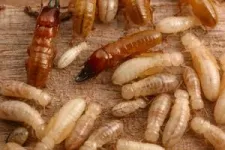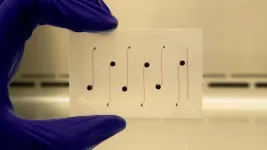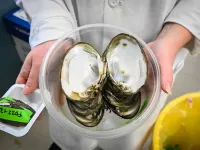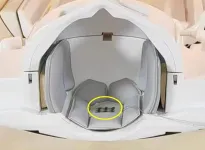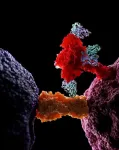(Press-News.org) In May 2022, the Facility for Rare Isotope Beams (FRIB) at Michigan State University (MSU), launched its precision measurement program. Staff from FRIB’s Low Energy Beam and Ion Trap (LEBIT) facility take high-energy, rare-isotope beams generated at FRIB and cool them to a lower energy state. Afterward, the researchers measure specific particles’ masses at high precision.
The LEBIT team, led by Ryan Ringle, adjunct professor of physics at FRIB and in the MSU Department of Physics and Astronomy and senior scientist at FRIB, and Georg Bollen, University Distinguished Professor of Physics and FRIB Experimental Systems Division director, recently published a research paper that used the facility to take a step in verifying the mass of aluminum-22. Researchers think this exotic isotope demonstrates a rare but interesting property—specifically, that the nucleus is surrounded by a “halo” of protons that loosely orbit the nucleus. This halo structure reveals distinctive physical properties during its fleeting existence.
“This program requires a lot of extra beam preparation to perform experiments, and this is the first measurement in FRIB’s science program,” Ringle said. “This measurement could not have been done in a reasonable time at FRIB’s predecessor, the National Superconducting Cyclotron Laboratory, and it highlights our facility’s potential moving forward. Considering this was done with one-eightieth of FRIB’s power specification, this was like a warm-up before exercising.”
The team published its results in Physical Review Letters (“Precision Mass Measurement of the Proton Dripline Halo Candidate 22Al”).
Capturing elusive proton halos
While most atoms have electrons tightly orbiting the nucleus, protons and neutrons are part of the nucleus itself. However, when atoms encounter many of the same charged particles under certain conditions, they can create halos that orbit the nucleus beyond the pull of the strong nuclear force—the force that would normally keep these particles within the nucleus. While all halo structures are rare fleeting phenomena, neutrons are usually observed as halo particles. A nucleus’s positive charge usually repels protons’ positive charges, meaning that halos made of protons are even rarer. Measurements on nearby isotopes suggested that aluminum-22 might be an isotope that could form a proton halo, but researchers needed to verify this directly in other experiments.
To achieve this, the team creates a high-energy isotope beam of aluminum-22 using a process called “projectile fragmentation” at FRIB. The researchers create a beam from a heavy, stable atomic nucleus of a given element—in this case, an isotope of argon—then accelerate the beam to half the speed of light. The beam then hits a target with these ultra-fast-moving particle projectiles. This violent collision creates rare, short-lived isotopes that the researchers can shepherd into an instrument to filter out the particle of interest. They then lower the temperature to slow them down into a uniform beam and measure particle mass accurately.
While the team was able to accurately measure the mass of aluminum-22, it is only part of verifying the isotope’s proton halo structure. The LEBIT researchers’ colleagues in the Beam Cooler and Laser Spectroscopy (BECOLA) facility at FRIB now plan to take the next step in verifying the proton halo by measuring the charge radius—the distribution of protons around the nucleus—as well as how much the nucleus may be deformed from its traditional, spherical shape. Taken together, these measurements can unequivocally confirm the existence of a proton halo structure around aluminum-22.
Ringle pointed out that the collaboration between theoretical physicists and experimentalists at FRIB plays an essential role for research like determining the existence of a proton halo around a rare isotope such as aluminum-22.
FRIB provides research opportunities to graduate students
Ringle credited students on the team for playing a key role in advancing this research. One of LEBIT’s graduate students, Scott Campbell, took this project on as part of his dissertation.
“He really took charge of running this experiment from start to finish,” Ringle said. “The students who work with us really benefit from the wealth of expertise we have at this facility. Nowhere else is a facility like this located in the middle of a university campus. It allows students to come in for an hour or two between their classes or before they go home for the day. They can work at the lab part-time and easily pair that with taking classes. But our facility gets benefit as well; we have increased access to talented, motivated students.”
Campbell studied physics and computer science at Gonzaga University as an undergraduate. He was excited by the prospect of coming to MSU for graduate school in large part to FRIB being on campus and being a major resource for physics students. “I was very excited by the prospect of doing for nuclear physics research at MSU, especially with FRIB ramping up during my studies,” he said. “We have access to these great facilities and a great community, and we get to participate in groundbreaking advances in nuclear science.”
Campbell also noted that FRIB not only offers world-class facilities, but also networking opportunities and mentors like Ringle. “We are surrounded by colleagues who are interested in your research and want to help you push science forward,” he said.
Eric Gedenk is a freelance science writer.
Michigan State University operates the Facility for Rare Isotope Beams (FRIB) as a user facility for the U.S. Department of Energy Office of Science (DOE-SC), supporting the mission of the DOE-SC Office of Nuclear Physics. Hosting what is designed to be the most powerful heavy-ion accelerator, FRIB enables scientists to make discoveries about the properties of rare isotopes in order to better understand the physics of nuclei, nuclear astrophysics, fundamental interactions, and applications for society, including in medicine, homeland security, and industry.
The U.S. Department of Energy Office of Science is the single largest supporter of basic research in the physical sciences in the United States and is working to address some of today’s most pressing challenges. For more information, visit energy.gov/science.
END
New FRIB precision measurement program advances understanding of proton halos
Theoretical physicists and experimentalists work together to measure the mass of a rare isotope expected to form a rare proton halo, publishing the first results from FRIB’s precision measurement program
2024-05-31
ELSE PRESS RELEASES FROM THIS DATE:
A greener, more effective way to kill termites
2024-05-31
UC Riverside scientists have discovered a highly effective, nontoxic, and less expensive way to lure hungry termites to their doom.
The method, detailed in the Journal of Economic Entomology, uses a pleasant-smelling chemical released by forest trees called pinene that reminds western drywood termites of their food. They follow the scent to a spot of insecticide injected into wood.
“We saw significant differences in the death rates using insecticide alone versus the insecticide plus pinene,” said UCR entomologist Dong-Hwan Choe, who led the discovery. “Without pinene, we got about 70% mortality. When we added it in, it was over 95%.
Native ...
Engineered circulatory systems may help fight disease
2024-05-31
The pharmaceutical drug development and approval process is a multi-step undertaking that requires a plethora of testing before reaching the market. Even then, humans respond differently to drugs depending on their individual bodies and medical needs.
Dr. Abhishek Jain, associate professor in the Department of Biomedical Engineering, and his lab received a grant from Texas A&M Innovation to continue developing an advanced vessel-chip deployment platform for large-scale pharmaceutical testing services that holds promise for ...
Moffitt Cancer Center and Virogen Biotechnology forge groundbreaking partnership to accelerate oncology and immunotherapy innovations
2024-05-31
TAMPA, Fla., and PLEASANTON, Calif. — Moffitt Cancer Center, a world-renowned cancer treatment and research center, and Virogen Biotechnology Inc., a clinical-stage biotechnology company, announced a groundbreaking strategic partnership today. This collaboration aims to propel the development of Virogen's cutting-edge fusion protein, VG712 (Resimmune), addressing significant unmet needs in oncology and immunotherapy.
Under this strategic alliance, Moffitt will offer Virogen priority access to ...
Ivonescimab plus chemotherapy in non–small cell lung cancer with EGFR variant
2024-05-31
About The Study: Ivonescimab plus chemotherapy significantly improved progression-free survival with tolerable safety profile in patients with non–small cell lung cancer who previously underwent EGFR tyrosine kinase inhibitor (EGFR-TKI) treatment and may offer a new treatment option for patients with TKI resistance.
Quote from corresponding author Li Zhang, M.D.:
“For patients with non-small cell lung cancer whose illness has progressed while receiving EGFR tyrosine kinase inhibitor (EGFR-TKI) therapy, especially the ...
Mussels downstream of wastewater treatment plant contain radium, study reports
2024-05-31
UNIVERSITY PARK, Pa. — Burrowed into streambeds and rarely moving for their decades-long lifespans, freshwater mussels are biomonitors, meaning they indicate how clean their environment is, according to Penn State researchers. As the bivalves feed on organic matter and filter the water around them, their inner tissues and hard shells begin to reflect whatever is in their environment — including radioactive particles.
A pair of researchers from Penn State’s Department of Civil and Environment ...
This self-powered sensor could make MRIs more efficient
2024-05-31
MRI scans are commonly used to diagnose a variety of conditions, anything from liver disease to brain tumors. But, as anyone who has been through one knows, patients must remain completely still to avoid blurring the images and requiring a new scan. A prototype device described in ACS Sensors could change that. The self-powered sensor detects movement and shuts down an MRI scan in real time, improving the process for patients and technicians.
During an MRI scan, a patient must stay entirely still for several minutes at a time, otherwise “motion artifacts” could appear and blur the final image. To ensure a clear picture, patient movement needs to be identified as ...
Cognitive declines preceding Alzheimer’s diagnosis lead to credit card, mortgage delinquency
2024-05-31
(May 31, 2024) — In the years prior to an Alzheimer’s disease or other memory disorder diagnosis, credit scores begin to weaken and payment delinquency begins to increase, concludes new research led by Georgetown University. The findings show consistent deterioration in these financial outcomes over the quarters leading up to diagnosis. The findings also show that credit card and mortgage delinquencies, specifically, both increase substantially prior to diagnosis.
The research was released today by the Federal Reserve Bank of New York (FRBNY). (“The Financial Consequences of Undiagnosed Memory Disorders”).
“Most memory disorders ...
Eye-tracking techniques could help primary care providers diagnose autism sooner, more accurately
2024-05-31
INDIANAPOLIS — Nearly 3% of all children in the United States are diagnosed with autism, according to the Centers for Disease Control and Prevention. But a collaborative team of researchers at Indiana University and Purdue University are finding ways to make the right diagnosis sooner.
“The number of children needing autism evaluations exceeds the capacity of specialists trained to provide this service,” said Rebecca McNally Keehn, PhD, assistant professor of pediatrics at the IU School of Medicine. “Children and their families are currently waiting a year or more to access evaluations. ...
Antibodies may aid effort to fight influenza B: Study
2024-05-31
Researchers at Vanderbilt University Medical Center have isolated human monoclonal antibodies against influenza B, a significant public health threat that disproportionately affects children, the elderly and other immunocompromised individuals.
Seasonal flu vaccines cover influenza B and the more common influenza A but do not stimulate the broadest possible range of immune responses against both viruses. In addition, people whose immune systems have been weakened by age or illness may not respond effectively to the flu shot.
Small-molecule drugs that block neuraminidase, a major surface glycoprotein of the ...
ASCO: Novel CAR T therapy and shorter targeted therapy durations show promise for patients with leukemia
2024-05-31
Novel CAR T cell therapy obe-cel yields strong remission rates in adults with relapsed or refractory B-ALL (Abstract 6504)
The novel anti-CD19 autologous chimeric antigen receptor (CAR) T cell therapy obecabtagene autoleucel (obe-cel) achieved durable remissions in 40% of patients with relapsed or refractory B-ALL without a subsequent stem cell transplant (SCT), according to results from the Phase Ib/II FELIX clinical trial presented today by Elias Jabbour, M.D., professor of Leukemia.
At a median follow-up of 21.5 months, these patients were in ongoing remission ...
LAST 30 PRESS RELEASES:
Why a life-threatening sedative is being prescribed more often for seniors
Findings suggest that certain medications for Type 2 diabetes reduce risk of dementia
UC Riverside scientists win 2025 Buchalter Cosmology Prize
SETI Institute opens call for nominations for the 2026 Tarter Award
Novel theranostic model shows curative potential for gastric and pancreatic tumors
How beige fat keeps blood pressure in check
Fossils reveal ‘latitudinal traps’ that increased extinction risk for marine species
Review: The opportunities and risks of AI in mental health research and care
New map reveals features of Antarctic’s ice-covered landscape
Beige fat promotes healthy vascular function and blood pressure in mice
Chronic low-dose pesticide exposure reduces the life span of wild lake fish, China-based study shows
Tiny earthquakes reveal hidden faults under Northern California
Long-term pesticide exposure accelerates aging and shortens lifespan in fish
Professor Tae-Woo Lee's research group develops groundbreaking perovskite display technology demonstrating the highest efficiency and industry-level operational lifetime
The “broker” family helps tidy up the cell
Ecology: Mummified cheetahs discovery gives hope for species’ Arabic reintroduction
Researchers survey the ADHD coaching boom
Air pollution and cardiac remodeling and function in patients with breast cancer
Risk of suicide in patients with traumatic injuries
Post–intensive care syndrome
The lifesaving potential of opioid abatement funds
The Frontiers of Knowledge Award goes to Allan MacDonald and Pablo Jarillo-Herrero for their discovery of the “magic angle” enabling science to transform and control the behavior of new materials
Discovery reveals how keto diet can prevent seizures when drugs fail
JMIR Publications and Sikt announce pilot flat-fee unlimited open access partnership
Finding new cell markers to track the most aggressive breast cancer in blood
A new, cleaner way to make this common fertilizer
Fire-safe all-solid-state batteries move closer to commercialization
Disinfecting drinking water produces potentially toxic byproducts — new AI model is helping to identify them
Unplanned cesarean deliveries linked to higher risk of acute psychological stress after childbirth
Healthy aging 2026: fresh pork in plant-forward diets supported strength and brain-health biomarkers in older adults
[Press-News.org] New FRIB precision measurement program advances understanding of proton halosTheoretical physicists and experimentalists work together to measure the mass of a rare isotope expected to form a rare proton halo, publishing the first results from FRIB’s precision measurement program

